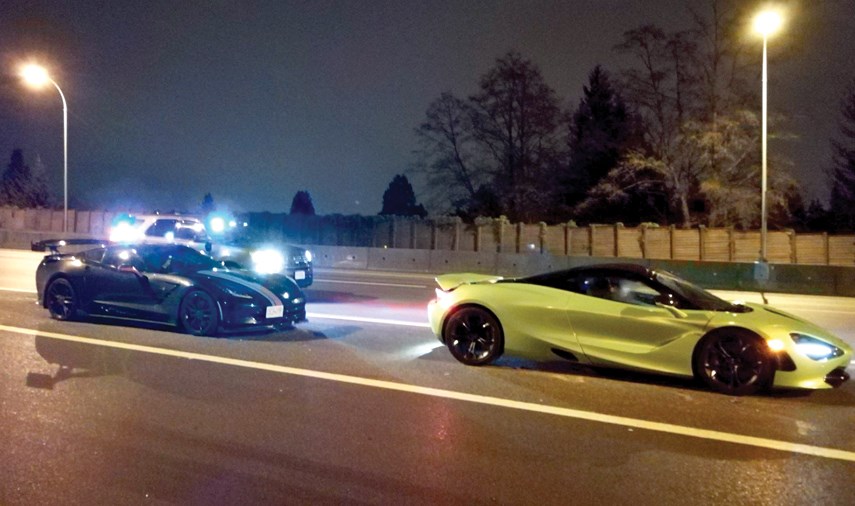Recently, a pair of young men had their sporting machines taken away by the West Vancouver Police Department for travelling at an alleged 150 kilometres per hour on the Upper Levels Highway, 70 km/h over the speed limit.
Public reaction was perhaps a bit mixed – if you travel regularly on that section of road, you’ll know that the actual rate of traffic is usually well above the limit – but overall there wasn’t much sympathy. One of the cars impounded was a 2018 McLaren 720S, valued above $300,000, and you’d be hard-pressed to find anyone who’d suggest the driver be left off with a warning.
Now, there are any number of arguments to be spurred by the late-night impounding. Should speed limits be more reasonable, so people actually pay attention to them? Should fines and penalties for speeding be based on income, as they are in countries like Switzerland?
Clearly, a bit of schadenfreude over some clearly well-off owner getting his fingers burned isn’t sufficient to actually improve public safety. There are a number of factors here that we should be discussing, especially as the number of vehicles being impounded continues to grow.
Let’s leave that aside for the moment, as I want to ask another question, one more pertinent to the future of the automotive industry: is driving a McLaren 720S at 150 km/h completely and utterly boring?
I’ll bet it is. On the wide, open stretches east of Hope, I can report that driving a Lamborghini Huracan at the posted limit of 120 km/h is about as interesting as watching a documentary about grain elevators. This is a car built for speed, and it aches to lunge forward – yet it cannot (legally).
You don’t even have to go the supercar route. A Tesla Model S, one with the 90 or 100 dual-motor designation, accelerates fast enough to be mildly uncomfortable, and can easily zip past the speed limit and into the waiting arms of the RCMP. That it does so quietly, and with Lamborghini-beating acceleration, is supposed to be part of the fun, but where’s the fun in worrying about the speed trap around every corner?
The solution is, of course, to take your even moderately fast car to the track (don’t take a Model S, though, they can’t handle it. Apparently the Model 3 does OK), and exercise your need for speed there. Easier said than done in B.C., what with the limited amount of tracks we have in the local area, but at least there’s the small one over on the island, and the gloriously smooth Area 27 out in the Okanagan.
However, there’s a problem. Go back a couple of generations, and fast cars were both lively and pretty difficult to drive. A Countach is supposed to be a complete bear. The F40 was a nightmare in the wet. Even the mighty V-8 muscle of the 1960s and ’70s required careful management.
Over the years, going fast has become easier and easier. Some friends of mine at Road & Track picked the McLaren 720S as their overall Performance Car of the Year because it was so easy to drive. As easy, they said, to get to the limit as a Mazda MX-5.
Now, I’m not suggesting that we make supercars as tricky to drive as they once were. Wealth is the only barrier to owning one of these things, and wealth does not necessarily go hand-in-hand with common sense or self-control. Just read the cover of any tabloid magazine in the supermarket checkout to see.
The problem is that a rising tide floats all boats, and it is now possible to buy a crossover from any of the mid-level luxury brands that would tear an old Ferrari’s face right off, and do so without drama. Range Rovers are prancing around the Nürburgring and setting hill climb records in China. Regular V-6 and turbocharged family sedans all seem to be able to run to 100 km/h faster than the best hot hatchbacks of the 1990s. The Kia Stinger – a Kia! - can run through the quarter mile in the high 12-second range.
In the near future, so it would seem, every car will be fast. Have speed limits increased? No they haven’t, but neither have the reaction times of human beings. As to the latter, it would appear that things are getting worse, both in terms of how distracted we often are, and in how we over-trust safety systems to keep up with our bad habits. As an example of such, consider how closely-packed North Shore traffic is in wet conditions, everyone just assuming their anti-lock brakes are magic.
When every car is quick, who buys a McLaren? More to the point, as there’ll probably always be a market catering to those with deep pockets, who buys a fast Mustang or Camaro or Boxster? Someday, even your average family crossover will be capable of putting out the same numbers that today’s sports cars do.
What will driving enthusiasts do? Well, those in the know are already aware that thrills aren’t found way up at the top end of the speedometer, but behind the wheel, in the driver’s seat. Companies will need to stop focusing on the specifications page, and try to create a more engaging driving experience. This is why Miatas are so much fun: it’s not how fast you’re going, it’s how much connection you have with the car and the road.
Whatever we decide to do with our roads and speed limits, it’s unlikely that it’ll ever be legal to drive at 150 km/h on the Upper Levels Highway, not even in a car that can stop on the proverbial dime, and not even when the roads are relatively empty. So, to end, a useful consumer tip: save your money and don’t buy a McLaren 720S. You don’t need a car that moves fast – you need a car that stirs you.
mcaleeronwheels@gmail.com



